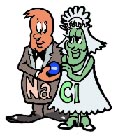Atomic Structure and Chemical Reactions
 Do all elements lose their top electrons in chemical reactions?
Do all elements lose their top electrons in chemical reactions?
 No; sometimes the opposite happens. Take a look at the second
column from the right in the periodic table--the one that starts
with fluorine (F).
No; sometimes the opposite happens. Take a look at the second
column from the right in the periodic table--the one that starts
with fluorine (F).
 These elements have their highest electrons in p orbitals--five at the same
energy. p has room for six, doesn't it?
These elements have their highest electrons in p orbitals--five at the same
energy. p has room for six, doesn't it?
 That's right. These elements are called the halogens; they're highly
reactive, too, but in a different way than the alkali metals. What sets
them off is not losing one of their own, but picking up a stray
electron, which fits perfectly into that "empty space" in the p sublevel.
That's right. These elements are called the halogens; they're highly
reactive, too, but in a different way than the alkali metals. What sets
them off is not losing one of their own, but picking up a stray
electron, which fits perfectly into that "empty space" in the p sublevel.
 Wow, it sounds like the halogens and the alkali metals would be perfect for
each other.
Wow, it sounds like the halogens and the alkali metals would be perfect for
each other.


 You're absolutely right; those two groups love to form compounds together.
For example, I'm sure you're familiar with sodium chloride, NaCl.
You're absolutely right; those two groups love to form compounds together.
For example, I'm sure you're familiar with sodium chloride, NaCl.
 What would the electrons look like in an element that wasn't very
reactive?
What would the electrons look like in an element that wasn't very
reactive?
 Look at the far right group, with helium (He) at the top.
Look at the far right group, with helium (He) at the top.
 Except for helium, all of these have a "full" p sublevel at the top, with six
electrons.
Except for helium, all of these have a "full" p sublevel at the top, with six
electrons.
 Yes. Helium, of course, has a "full" s sublevel--you
may recall that the first primary level
has only s orbitals. These guys are called the noble gases, and
they're perfectly happy with themselves as they are--no desire to give up or
take in electrons. As a consequence, they hardly ever form compounds with
other elements.
Yes. Helium, of course, has a "full" s sublevel--you
may recall that the first primary level
has only s orbitals. These guys are called the noble gases, and
they're perfectly happy with themselves as they are--no desire to give up or
take in electrons. As a consequence, they hardly ever form compounds with
other elements.

 In general, the arrangement of the outermost electrons, called valence
electrons, tells you all about an element's chemical behavior.
In general, the arrangement of the outermost electrons, called valence
electrons, tells you all about an element's chemical behavior.






